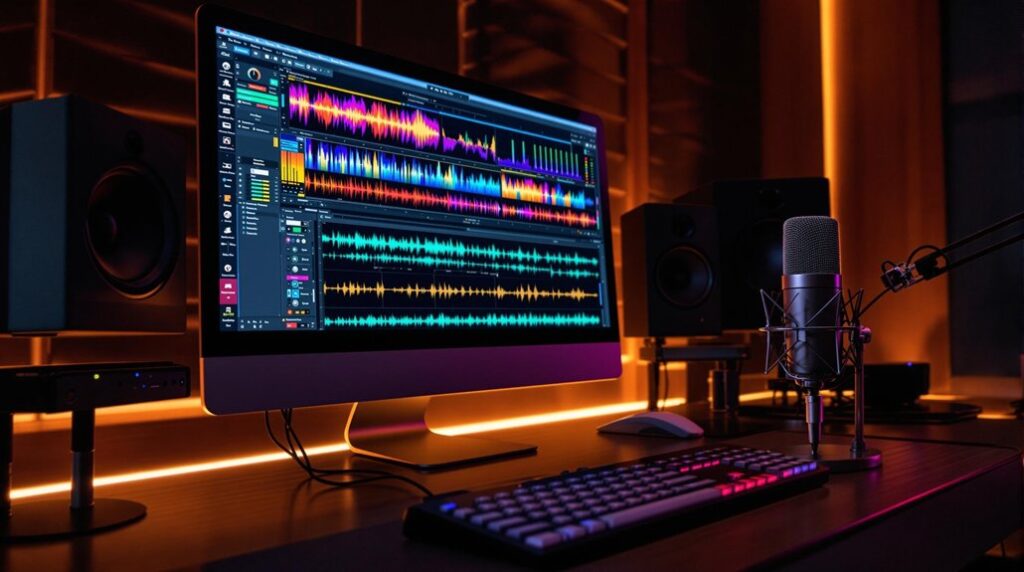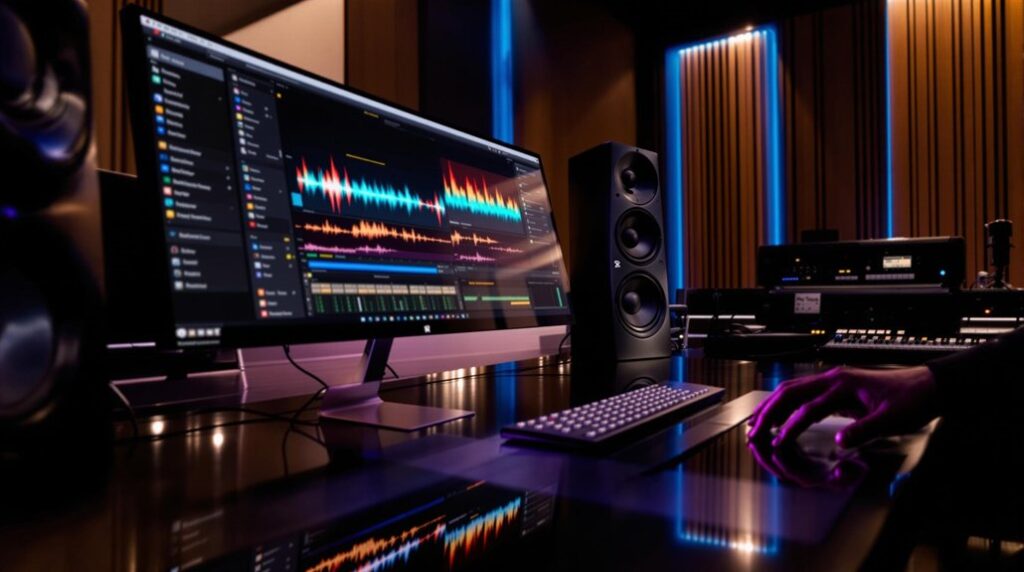To set up a master fader in Pro Tools for ideal audio levels, initiate by maneuvering to Track > New to create a stereo master fader track. Set the input to none and the output to Output 1-2 for correct signal flow. Engage in real-time automation to guarantee dynamic volume adjustments, while monitoring meters to maintain levels below -6 dBFS, safeguarding against clipping. Implement gain staging and audio processing, such as compression and EQ, for a polished, balanced mix. Employ best practices like conservative gain on individual tracks and frequent level monitoring to maintain headroom. Reveal further insights into mastering audio levels effectively.
Key Takeaways
- Navigate to Track > New, set to 1 track, Stereo channels, and select Master Fader as type.
- Confirm the master fader's input is set to none and output is set to Output 1-2.
- Maintain the master fader at 0 dB for ample headroom and prevent clipping.
- Regularly monitor levels with meters to ensure balanced output and avoid distortion.
- Use automation modes for dynamic volume adjustments and enhanced audio control.
Importance of Master Fader
In the area of audio production, the master fader in Pro Tools is indispensable, serving as the central control point for the session's output volume.
The master fader track centralizes the regulation of overall signal level, ensuring cohesive mixing and preventing clipping, which is vital for maintaining ideal headroom. By enabling real-time automation, it offers dynamic volume adjustments, enhancing the listener's experience. It is also important to monitor loudness levels to avoid clipping and maintain a balanced mix.
In addition, it facilitates the incorporation of processing effects, such as compression and EQ, applied to the final mix for a polished sound. Regular monitoring of the master fader's output volume is essential, as it maintains sound integrity and balance across all audio elements.
Consequently, it is integral to an audio engineer's toolkit for achieving professional-grade mixes.
Steps to Create a Master Fader
Understanding the importance of the master fader, audio engineers must know the precise steps to create it within Pro Tools.
Begin by steering to Track > New…, where you will configure the parameters to create a Master Fader track. Set it to 1 track, Stereo channels, and select Master Fader as the type. Click "Create," and the Master Fader track will appear as Master 1 in the track list.
Access the Mix Window via Window > Mix to locate the Master Fader controls. Confirm the Input is set to none, and the Default Output is Output 1-2.
Adjust the fader level to manage the overall volume, linking it to other audio tracks for cohesive adjustments. Regularly monitor levels to prevent clipping. Consider using session templates to streamline your workflow and enhance consistency across projects.
Configuring Your Master Fader
Configuring your master fader in Pro Tools involves careful attention to output levels and mix dynamics to guarantee audio integrity.
Begin by setting the Master Fader's output to Output 1-2, allowing for accurate routing to your monitoring system while keeping the input set to none.
Utilize the fader and its metering capabilities to maintain ideal headroom at 0 dB, preventing clipping and guaranteeing a balanced mix across all tracks.
For optimal results, understanding the importance and efficiency of signal flow in Pro Tools is crucial, as it can greatly influence audio clarity and mixing flexibility.
Setting Output Levels
Achieving ideal sound quality in your Pro Tools session begins with setting the output levels of your Master Fader. Confirm the Master Fader's output is configured to Output 1-2, aligning it with your session's main stereo output.
To adjust this, click on the Master Fader track's output label and select the MON L/R (Stereo) option from the drop-down menu. It's essential to monitor and adjust these levels to maintain consistent output volume and avert clipping.
Integrating plugins on the Master Fader can facilitate global processing, including compression or EQ, enhancing the overall mix's output before finalization.
Regularly observe the Master Fader meters, confirming levels remain below 0 dBFS to prevent distortion and maintain pristine audio integrity.
Monitoring Mix Dynamics
For ideal control over your Pro Tools session's sonic environment, vigilant monitoring of mix dynamics via the Master Fader is essential.
Start by setting the master fader's input to none, ensuring it governs overall output without interference. Monitor levels meticulously with the master fader's meters to identify clipping risks and sustain a coherent mix.
Adjust the master fader during playback to achieve optimal mix levels, attentively watching for the clip light to prevent distortion.
Employ automation on the master fader to introduce dynamic volume shifts, augmenting expressiveness and maintaining listener engagement.
Incorporate plugins on the master fader to process the complete mix, consistently monitoring levels to preserve sound integrity across all tracks in the session, ensuring peak audio fidelity.
Mixing Techniques With Master Fader
Mastering the art of mixing with a master fader in Pro Tools is essential for audio engineers aiming for a polished final product. The master fader allows precise control over the overall signal, ensuring it remains at 0 dB for ideal headroom without clipping. By implementing automation, engineers can introduce dynamic volume changes, adding emotional depth to the mix. It is critical to monitor the master fader's level meters, maintaining levels below -6 dBFS to prevent distortion. Experimentation with compression and EQ on the master fader can greatly shape the overall sound. When using multiband compression, it's important to carefully set your crossover frequencies to effectively target specific frequency bands while maintaining clarity. Here are key techniques:
- Utilize Automation: Enhance emotional impact through dynamic changes.
- Monitor Levels: Avoid clipping by keeping levels under -6 dBFS.
- Apply Effects: Use compression and EQ for final sound shaping.
Master Fader Automation Tips
Master fader automation in Pro Tools provides an essential tool for executing dynamic volume adjustments, enabling engineers to sculpt nuanced audio environments through precise envelope lines.
By automating fader levels in real-time during playback, one can maintain control over the mix's energy, ensuring that volume shifts are both smooth and impactful.
Utilizing Read and Write automation modes further enhances the ability to capture accurate fader movements, thereby facilitating refined control over the mix's dynamic range.
Dynamic Volume Adjustments
Harness the power of automation in Pro Tools to achieve dynamic volume adjustments on your master fader, elevating your mix to professional standards.
Begin by enabling the automation mode: click the "A" button on your master fader track and select the volume parameter. This allows you to control volume dynamics precisely, ensuring ideal audio levels without clipping during playback. Monitoring these levels is essential to maintaining sound integrity.
To effectively implement dynamic volume adjustments, follow these steps:
- Enable "Write" Automation Mode: Record real-time adjustments on your master fader, capturing intended volume dynamics directly into the session.
- Set and Adjust Automation Points: Regularly monitor and refine these points during playback to prevent distortion.
- Switch to "Read" Mode: Allow Pro Tools to execute automated volume changes, ensuring a smooth, polished mix.
Real-Time Fade Control
Achieve precise control over your mix's dynamics by utilizing real-time fade control on your Master Fader in Pro Tools. Engage the automation feature by selecting the master fader track and choosing an appropriate mode—Read, Write, or Touch—to manipulate mix levels dynamically. Draw fade-in or fade-out curves directly on the master fader track to adjust the overall signal, ensuring seamless shifts without clipping. Monitor levels vigilantly to maintain output below 0 dBFS. Employ the "Trim" mode for nuanced volume adjustments to preserve existing automation integrity. Experiment with various fade shapes, such as linear or exponential, to enhance your mix's emotional impact.
| Automation Mode | Purpose |
|---|---|
| Read | Plays existing automation data |
| Write | Records automation data |
| Touch | Writes automation only when touched |
| Trim | Adjusts volume without altering points |
Avoiding Clipping and Distortion
In any audio production environment, preventing clipping and distortion is paramount to achieving a clean and professional mix. Within Pro Tools, the master fader serves as an essential component for managing output levels to avoid signal clipping and resultant distortion.
To effectively prevent these issues, adhere to the following practices:
- Maintain Headroom: Keep the master fader at 0 dB to guarantee ample headroom, preventing signals from exceeding the 0 dBFS threshold.
- Monitor Output Levels: Utilize meters to vigilantly track output levels, adjusting the master fader as necessary to maintain balance and prevent clipping.
- Conservative Gain Staging: Avoid excessive gain on individual tracks, which can accumulate and cause clipping at the master fader, guaranteeing a cleaner signal path and mix output.
Additionally, volume balancing is essential to ensure clarity without overshadowing elements in the mix, contributing to a cohesive and polished sound.
Best Practices for Master Fader Use
Master the art of using the master fader in Pro Tools by adhering to best practices that guarantee a polished and professional audio mix. Maintain the master fader at 0 dB to maintain maximum headroom, preserving dynamic range while avoiding clipping. Regularly monitor levels via the master fader's meters to keep the mix balanced and within safe limits. Employ automation to introduce dynamic volume variations, enhancing the track's emotional resonance without manual intervention. Remember, the master fader should not serve as a primary volume control; instead, adjust individual track types for a balanced mix before finalizing with the master fader. Secure your progress by saving mix settings frequently and comparing with reference tracks for consistent quality. Object Grabber Mode in Pro Tools promotes specific clips from auditions to the main playlist, streamlining the comping process.
| Best Practice | Benefit |
|---|---|
| Master fader at 0 dB | Maximum headroom |
| Monitor levels | Balanced mix |
| Use automation | Enhanced emotional impact |
| Adjust track types | Primary volume control avoided |
Frequently Asked Questions
How to Set up Master Fader Pro Tools?
To set up a master fader in Pro Tools, create a stereo track, ensuring output routing to 1-2. Adjust mix levels, monitor output sound, and control dynamics. Enhance the final mix by utilizing plugins effectively for creating audio balance.
What Does the Master Fader Do on the Audio Mixer Control?
The master fader on an audio mixing console regulates fader levels, affecting the signal flow and ensuring ideal gain staging. It facilitates dynamic range control and mix balance, allowing precise adjustments to the overall output level for distortion-free playback.
What Is the Difference Between Track Faders and Master Faders?
Track fader functions involve individual level adjustments and automation for mixing dynamics within a session. The master fader role encompasses overall signal flow management and audio control, ensuring cohesive output levels and preventing clipping in the final mix.
Is Master Fader Stereo or Mono?
Master fader types in audio mixing involve both stereo and mono options. Stereo master faders offer superior audio level control and balanced fader signal flow across channels, essential in mixing console basics and advanced audio mixing techniques.
Conclusion
The integration of a master fader in Pro Tools is essential for maintaining ideal audio levels throughout the mixing process. By following the outlined steps to create and configure a master fader, one can achieve improved balance and clarity in the final mix. Employing advanced mixing techniques and automation guarantees dynamic control, while vigilance in avoiding clipping and distortion preserves audio integrity. Adhering to best practices solidifies a professional outcome, enhancing the overall quality of audio production.




